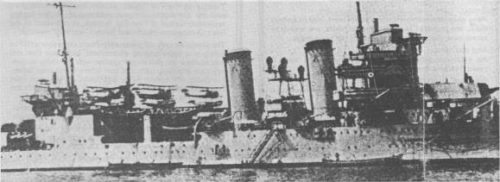- Author
- Thomson, Max
- Subjects
- Ship histories and stories, WWII operations
- Tags
-
- RAN Ships
- None noted.
- Publication
- June 1989 edition of the Naval Historical Review (all rights reserved)

Ships arrive off Sydney Heads under steam, under sail, under tow and even underwater in the case of submarines.
But one ship arrived backwards!
Amid dramatic circumstances, it was involved in a remarkable feat of long-distance seamanship. But publicity that would normally focus on such a unique arrival, especially involving such a big ship, was stifled by wartime censorship restrictions.
Centrepiece of the drama was the 10,000-tonne USS New Orleans, a heavy cruiser of the United States Navy’s wartime Pacific fleet.
USS New Orleans steamed from the Solomons to Sydney stern-first after the whole of its massive bow section had been blown off by torpedoes from attacking Japanese destroyers during a spectacular night battle.
Sydneysiders had seen their harbor invaded in May 1942 by midget submarines of the Japanese Navy launched from their big mother-subs off Sydney Heads.
In December of that same year of 1942, the sight of USS New Orleans struggling into Sydney with her bow blown away, laying open shattered and twisted steel, brought home again the grim horrors of the war at sea.
An Astoria-class cruiser built in 1933, USS New Orleans was a big warship. Nearly 200 metres long, she mounted nine 8-inch guns, big batteries of anti-aircraft weaponry and carried a ship’s company well in excess of 1000 men. The ship was a major unit of the US Navy’s cruiser forces operating in the Pacific.
She had been serving with a force comprising the heavy ships USS Northampton, USS Minneapolis, USS New Orleans and USS Pensacola, plus the light cruiser USS Honolulu and fleet destroyers screening the cruiser force. Rear Admiral C.H. Wright USN commanded this Task Force 67.
Near midnight on November 30, 1942, in what became known as the Battle of Tassafaronga, the American ships engaged Rear Admiral Tanaka’s 2nd Destroyer Flotilla of the Imperial Japanese Navy, comprising eight ships, some of which were carrying troops and supplies to Guadalcanal and other Japanese-held areas of the Solomon Islands.
Japanese torpedoes, which were superior at that time to those used by the Americans, wreaked terrible havoc on the US warships. In the night battle, USS Northampton was sunk, Minneapolis and New Orleans had their bows blown off and Pensacola was severely damaged.
One of the Japanese destroyers, Takanami, was sunk. After the engagement, USS Minneapolis struggled to Tulagi harbor and she lay there for a time hidden under camouflage netting.
USS New Orleans was unable to head into the seas with her great bow blown away. In a feat of sheer ingenuity, trunks of coconut trees were cut and brought on board to help shore up the great section exposed to the elements when the bows were blown away.
A decision was made to steam the warship backwards — stern first — from the Solomons all the way to Sydney, for temporary repairs at least.
Alongside Garden Island naval base, Australian workmen fitted a false bow to USS New Orleans, enabling the big ship to steam across the Pacific to an American shipyard where a whole new permanent bow was built and fitted.
It was almost a year before the three damaged cruisers — New Orleans, Minneapolis and Pensacola — could rejoin the fleet.
Australia had a special affinity with USS New Orleans. Not only did the cruiser return here in such spectacular manner for initial repair by Australian workmen, but the location where her battle had taken place off Savo Island was close to where the Australian cruisers HMAS Australia, Canberra and Hobart had been in action supporting other US cruisers just a shade earlier.
HMAS Canberra had been badly damaged. Eighty-four of her ship’s company were killed, died of wounds or were declared missing; and 109 of her men were wounded.
Unlike New Orleans, there was no hope of getting HMAS Canberra back to Sydney for, unable to steam and listing badly, she finally had to be sent to the bottom.
USS New Orleans survived the war and 14 years later, in 1959, was scrapped at a shipyard at Baltimore, USA.
There are still Manly ferry commuters who can recall vividly the horror they felt at passing Garden Island where, alongside what is known as the Cruiser Wharf, they saw the spectacle of the crippled New Orleans with its great bow section blown away completely.
And there are American crewmen still living in US who are eternally grateful for the job of work done by Australian shipyard repair men in patching up their ship after it had limped all the way from the Solomons to Sydney — backwards.
(Courtesy Australasian Post, Jan. 16, 1988)




